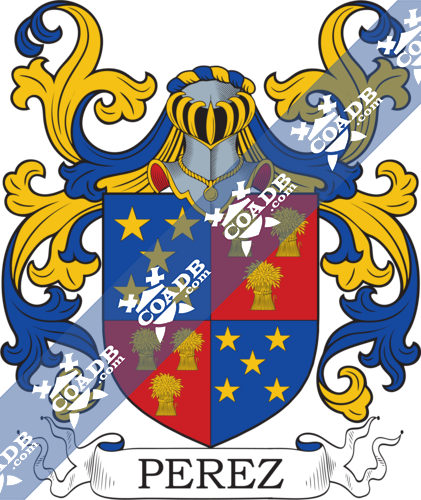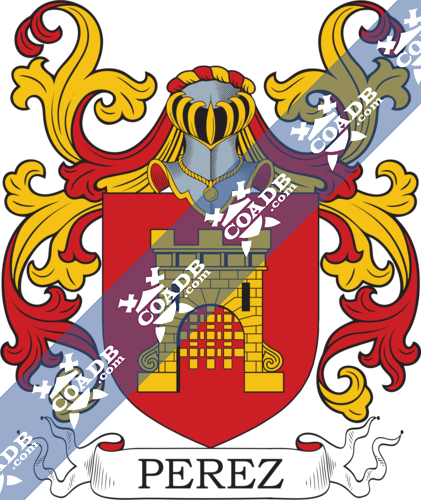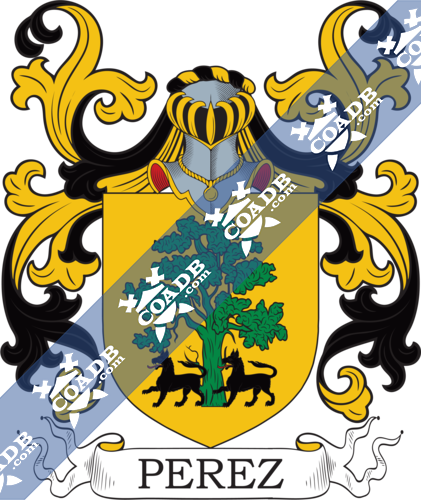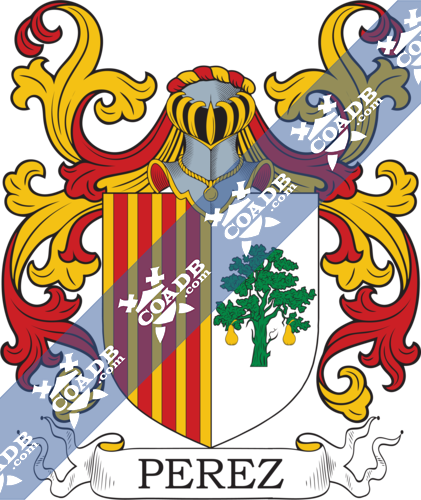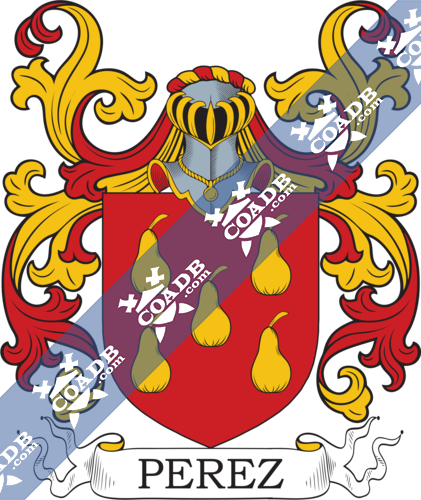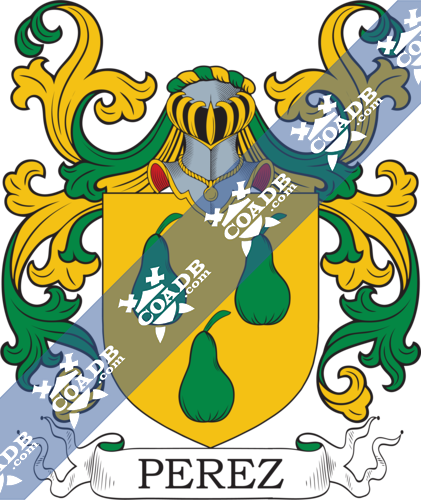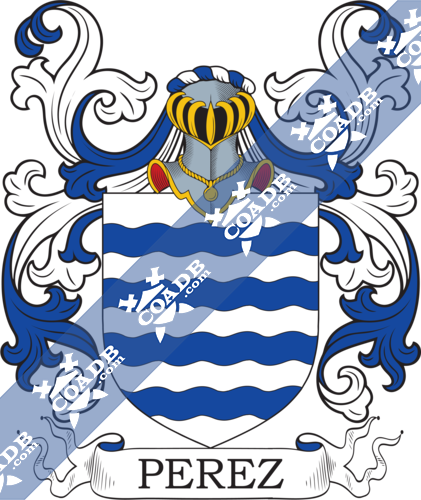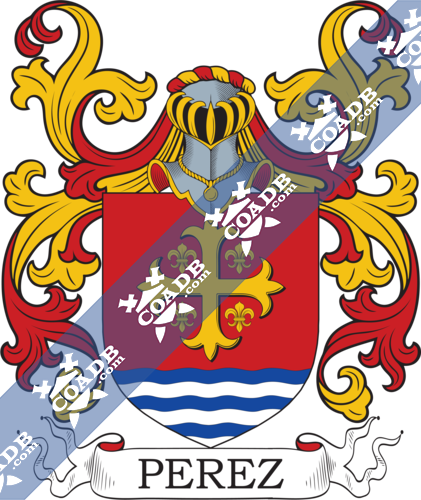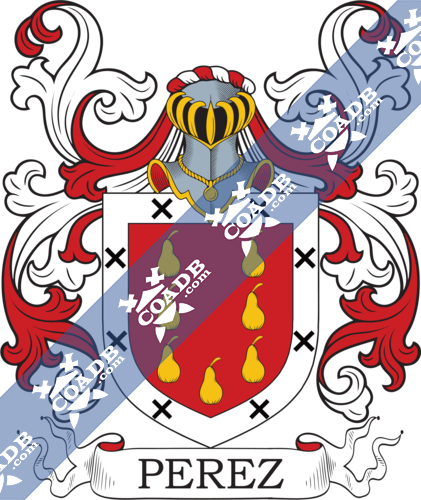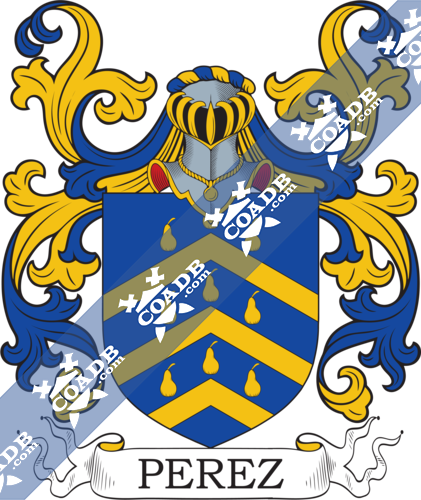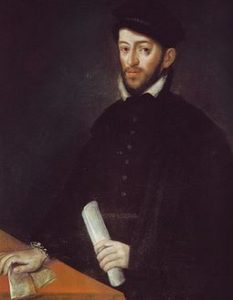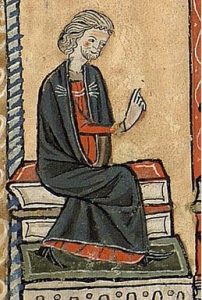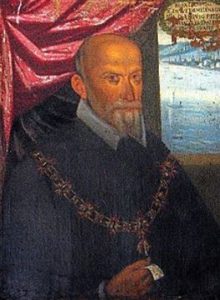Perez Family Crest, Coat of Arms and Name History

Perez Coat of Arms Gallery
Don’t know which Coat of Arms is yours?
We can do a genealogical research. Find out the exact history of your family!
Learn MoreSurname Meaning, Origin, and Etymology
Pérez is one of the most popular surnames in the world, and it is originally from Spain, where it has thousands of bearers as do South American countries that used to be colonies of this European nation. It is also one of the first hereditary surnames, which means that they were passed from father to son. Pérez means “son of Pedro” or “son of Peter,” which means that this is a patronymic surname, which is very evident thanks to the suffix “ez” that grants it the meaning of “son of…” It has a religious origin because Pedro was one of the Disciples of Christ, which motivated people started to name their sons after him to honor the biblical character or to get protection from the saint for their child. This was a very common practice during medieval Europe.
The name Pedro or Peter, and the surname Pérez was spread across Europe and other continents during the crusades when the original names of the regions were substituted with the names of the conqueror. This would happen again during the conquest of South America by Spain when this surname and many others were brought to the New World.
There were many surnames derived from the name Pedro, and there is a form of Pérez in every country of Europe. This caused there to be thousands of variations of this popular surname. One of the first records of this surname is from 1155 and belongs to Pelayo Pérez de Fromesta, a knight from Castile.
Spelling Variations
Due to the wide reach of this surname – attributed to the crusades and its religious background, which caused that there was a form of Pérez in every language – the fact that during the medieval era many names were written according to how they were pronounced, and the mix of languages at the time, this surname has several spelling variations. The most popular variations were Pérez, Perez, Pédriz, Pedriz, Périz, Pétrez, Pétriz, Petriz, Pédrez, Pedrez and others – such as Peters, Peterson, Peers and even Piotrek, Petrenko and Pietrusska – that belong to languages from other regions beyond Spain. In cases such as Pérez and Perez, they are different surnames due to the accent mark, which caused these words to have a different pronunciation in Spanish. Therefore, they are different words and variations of the same surname.
Popularity & Geographic Distribution
The reasons that caused all the spelling variations of the surname Pérez also help explain its popularity. So, it is not a surprise that in the rank of most popular surnames in the world, Pérez holds the 82nd position, as well as a huge amount of bearers all over the world, which is approximately 5,815,428. Pérez is most prevalent in Mexico, and it has its highest density in Cuba. The second country where Pérez is most popular is Spain – its country of origin – and in third place is Venezuela, a country that used to be a Spanish colony. This is information taken from the census of 2014.
Early Bearers of the Surname
Thanks to the popularity of the surname Pérez, there are several records of early bearers in different places and at different points in history. Among those with spelling variations of the surname was Ralph Peter, who appeared in the pipe rolls of the county of Hertford in 1195 during the reign of King Richard I of England, aka “Lion Heart.” There is also a record of Luke Petre of London, England in 1282 and William Petres of Somerset, England in 1327. Among those with the surname’s actual form were María Pérez, an important heroin from Castile who fought and won against King Alfonso of Aragon, Andrés Guillén Pérez from Zaragoza, Spain on a record from December 7, 1565, and Josepha Pérez from Santa Catarina, Mexico on a record from December 23, 1775.
History, Genealogy, and Ancestry
Thanks to the popularity of the surname Pérez, its history and genealogy is very long; so much so, that in some cases it is impossible to trace. Since this is a patronymic surname, most of the Pérez families are not related to each other.
There are several records of Pérez families, but one of these belongs to different Pérez families from Antioquía, a province of Nueva Granada in America, which is now known as Colombia. There were 9 lines of Pérez families in total in Antioquia.
The first line started with Juan Pérez de Montilva, who settled in Antioquía between 1560 and 1565. He was involved with a native woman called Angelina, and had several children with her. The first one was a daughter named Juana Pérez de Montilva, who was born in 1567 and married Domingo Hernández Gallego from Spain; they had six children, some of whom inherited the surname Pérez and had children of their own in Antioquía. After her husband died, Juana had other children such as Juana Vásques de Montilva, who married Andrés Sánchez, Juan Martín, Alonso Martín, and Catalina Pérez de Montilva, who married Alvaro Jaramillo Sánchez and later married Antonio Pimentel Guzmán.
The second child of Juan Pérez and Angelina was Antón Pérez de Montilva, who married María de la Vega, a mulatto woman. One of their sons was Francisco Pérez de Montilva, who married Luisa Monsalve o Saavedra in 1614. They had ten children: two sons and eight daughters. There are no records of their sons, but their daughters were Paula, who married Jacinto Ortiz Irigoyen; Luisa, who had three children and then got married to José de Berrío; Francisca, who had six children, and Magdalena, who had five children and died in 1697 in Medellín. The daughters of Magdalena were Isabel Pérez Mendez del Castillo, who had eight children; Gregoria Pérez de Aguiiar, who had two children, and Manuela Pérez, who had six children from five different men.
The second line began with Alonso Pérez de Ureña, a Spanish man from Ciudad Real who was born in 1545. He settled in Antioquía with his wife María Valeros during 1570; she was also Spanish. They had two sons – of whom there aren’t any records – and they had also a daughter, Ana Pérez de Poblete, who married Domingo Gómez de Ureña Pérez. All the Pérez families of Valle de Aburra, descend from this last marriage.
The third line started with Alonso Pérez Maraver de la Reina, who was the priest of Antioquía, where he died in 1612. He had a daughter with an unknown woman. The child was named María Maraver de la Reina, and she got married on June 15, 1617 to Alonso de Agudelo Hernández-Crespo.
The next line began with the sergeant Cristóbal Pérez de Rivero, a Spaniard from Asturias. He settled in Valle de Aburra, where he married Margarita Velásquez Gómez. They had a daughter named Juana Pérez de Rivera Velásquez, who married Pedro Losada Sotelo, in Medellín in 1684. Juana got married a second time to Miguel de la Cerda-Gordón Upegui in 1699. After having this daughter, Cristóbal got married to Sebastina López de Restreplo Guerra-Peláez. Cristóbal died in Medellín on August 31, 1703. Cristóbal and Sebastina had six children, the first of which was Cristóbal Pérez de Rivero Restrepo, who became a priest in La Estrella. The second child was Catalina Pérez de Rivero Restrepo, who married Mateo Peláez Benítez-Colmenero. The next child of Cristóbal and Sebastina was Andrea Pérez de Rivero Restrepo, who married Francisco Sánchez de la Hinojosa Peláez in Medellín in 1714. And finally, Josefa Pérez de Rivero Restrepo, who married José Antonio Isaza Atuesta in 1715.
The next daughter was Ana Josefa de Rivero Restrepo, who got married to Doming Gómez de Rivero, in 1719, he was a Spanish. Then, there was a son, Andrés Pérez de Rivero Restrepo, who married Manuela Tazón de Rivilla Arnedo in Medellín in 1708. From this marriage, descend all the Pérez of Otrabanda, today called Belén.
The sixth line of tbe Pérez families from Antioquía starts with Sebastían Pérez Moreno de Herrera from Spain, who settled in Valle de Aburra. He got married to Josefa Palacio Mejía, and they had five children. First, they had Mariana Pérez Palacio, of whom there aren´t any records. Then, they had Elvira Rosa Pérez Palacio, who got married to Francisco Javier Mesa Alvarez in 1707 in Medellín; Sebastian Pérez Palacio, who got married to María Teresa Acevedo Vibancos in 1695 and had two children – Gabriel José and Lucía María. The next child of Sebastián and Josefa vas Gertrudis Pérez Palacio; she was the first wife of Pedro Acevedo Vibancos, the brother of María Teresa, who was wife of his brother Sebastián. And finally, Juan Pérez Palacio who married Josefa Tazón de Rivilla Arnedo in 1692; they had only one son: Ignacio Javier Pérez Tazón, who married Juana María Cárdenas Gómez de Castro in 1721.
The next branch of the Pérez families in Antioquía starts with Patricio Felipe Pérez Bueno, a Spaniard. He married María Gregoria Rodil Bargas-Machuca in 1700 in Antioquia, and they had two daughters and one son.
The eighth line began with Javier Pérez-Pereira, a Portuguese man who settled in Arma and married Isidora Romero. One of their children was Gabriel Pérez-Pereira Romero, who lived in Rionegro, where he married María Magdalena Ruiz Ramírez in 1696. Gabriel and María had 11 children, including María Magdalena Pérez Ruiz, who had a son, Javier Montoya Benjumea and then married Nicolás López Arias, a carpenter. There was also Josefa Pérez Ruiz, who married Juan Carlos Giraldo Ayala and Agustín Pérez Ruiz, who in 1734 got married to Francisca Ospina Franco. The next children were Ignacio Pérez Ruiz, who married Inés Ramírez o Gutierrez in 1737 and Manuel Salvador Pérez Ruiz, who on July 26, 1739 married María Josefa López Arias, sister of Nicolás, who was husband of María Magdalena.
The final line begins with Vicente Pérez López, a Spanish man who married Susana Campuzano Bernal on January 10, 1814. Their child was Juan Cancio, who married Amelia Mejía Isaza in 1835; they had six children: five sons who had their own children and one daughter, Rosa María Juliana Joaquina de Jesús, who got married to Esmaragdo Agapito in 1843. This last marriage didn’t result in any children.
Early American and New World Settlers
Many bearers of the surname Pérez traveled from Europe to America over the course of many years. Some of the most remarkable New World settlers were Juan Pérez de Sorita of Cordoba, who landed in Peru in 1550 and then moved to Argentina in 1557; Inés Pérez, who arrived in Honduras in 1560; Andrés Pérez, who arrived in Peru in 1560, and Diego Pérez, who arrived in Hispaniola in 1562.
The arrival of people with the surname Pérez continued, and during the 19th century, more of them landed in America, such as Francisco Pérez in 1810, Alonso Pérez in 1812, and Andrés Pérez also reached the new continent. Then, Bartolome Pérez landed in America in 1813, and Ferran Pérez did the same in 1814.
Mottoes
We were unable to locate any documented mottoes for the Pérez family.
Grantees
We were unable to locate any documented grantees for the Pérez family.
Notables
There were bearers of the surname Pérez that played a major role in different areas. Among the most important were Juan Bautista Pérez (1869-1952), a lawyer and magistrate from Venezuela who was President from 1929 until 1931, Álvaro Mejía Pérez (b. 1982), a football player from Spain, Isidro Pérez (1964-2013), a boxer from Mexico who won the WBO Flyweight Championship on two occasions, and Beach Volleyball player from Puerto Rico Raúl Papaleo Pérez (b.1971). Other notable bearers include Tony Pérez (b.1942), an American actor and Venezuelan diplomat and lawyer Juan Pablo Pérez Alfonzo (1903-1979), who was the main creator of the OPEC. The list continues with José Joaquín Pérez (1801-1889), an important figure in the politics of Chile and Marcos Pérez Jiménez, President of Venezuela from 1952 until 1958; he wasn’t the only President of Venezuela to bear the surname Pérez, as there was also President Carlos Andrés Pérez (1922-2010). Other famous bearers include Erik Pérez, a mixed martial artist from Mexico, Spanish painter Bartolomé Pérez (1634-1693), and many others.
Blazons & Genealogy Notes
1) Espagne – De gueules à une croix fleuronnée d’or cantonnée de quatre fleurs-de-lis du mêmeEnglish: Gules with a cross floretty or having in each quarter a fleur de lys of the same.
2) Espagne – D’argent maçonné de sable à la fasce de gueulesEnglish: Argent masoned sable a fess gules.
3) Flandre – Écartelé aux 1 et 4 de gueules à une tour d’or aux 2 et 3 d’azur à une fleur-de-lis d’argent L’écu entouré d’une bordure d’azur ch de huit coquilles d’argent Cimier la tour Lambrequin d’or et de gueulesEnglish: Quarterly 1st and 4th gules with a tower or 2nd and 3rd azure with a fleur de lys argent the shield entirely within a bordure azure charged with eight escallops argent Crest: the tower Mantling: or and gules.
4) Aragon, Estrémadure – De sinople à une tour sommée d’une tourelle d’argent posée sur une terrasse rocheuse et sommée d’un bras armé d’argent brandissant un flambeau allumé à la bordure d’argent ch en chef et en pointe d’un pal d’azur et à chaque flanc d’une fasce d’azur et ayant dans chaque canton un carreau de sable ch d’une étoile (8) d’orEnglish: Vert with a tower surmounted by a turret argent placed on a rocky mount and surmounted by an arm armed argent brandishing a torch aflame a bordure argent charged with in chief and in base a pale azure and with each flank a fess azure and having in each quarter a square sable charged with a etoile of 8 points or.
5) (Barons) – Allemagne – Écartelé aux 1 et 4 d’or à la demi-aigle de sable mouvante du parti aux 2 et 3 de gueules à une tour d’or surmontée de deux étoiles du même et acc de trois pommes de pin de sinople les queues en haut deux en flancs et une en pointe le tout renfermé dans une auréole d’or Casque couronné Cimier un bras armé tenant une épée enfilant une tête de Turc dégouttante de sang le tout au naturel Lambrequin à dextre d’or et de sable à senestre d’or et de gueulesEnglish: Quarterly 1st and 4th or with a demi eagle sable coming from the partition [pale] 2nd and 3rd gules with a tower or surmounted by two etoiles of the same and accompanied by three pine cones vert the tail upwards two in the flanks and one in base all contained in a halo or Crowned with a helmet Crest: an arm armoured holding a sword spearing a head of a turk vomiting blood all proper Mantling: to the dexter or and sable to the sinister or and gules.
6) Brabant – Écartelé aux 1 et 4 d’argent à l’aigle de sable à la bande d’azur brochant sur l’aigle aux 2 et 3 fascé d’or et d’azurEnglish: Quarterly 1st and 4th argent with an eagle sable a bend azure covering over the eagle 2nd and 3rd barry or and azure.
7) Autriche – D’or à la fasce d’azur à une grue d’argent becquée et membrée de gueules avec sa vigilance de sable posée sur un tertre de sinople ladite grue brochant sur la fasce et tenant en son bec une plume à écrire au naturel en bande le bec de la plume en bas Casque couronné Cimier la grue tenant en son bec au lieu de la plume deux poissons d’azur passés en sautoir les têtes en haut Lambrequin d’or et d’azurEnglish: Or a fess azure with a crane argent beaked and legged gules in its vigilance sable placed on a hillock vert the aforesaid crane covering over the fess and holding in its beak a quill pen proper bendwise the nibs of the feather downwards Crowned with a helmet Crest: the crane holding in its beak instead of the feather two fish azure placed saltirewise the heads upwards Mantling: or and azure.
8) de Moreno – Castille, Catalogne – D’or à un château sommé d’une tour de gueules cette tour accostée de deux corbeaux essorants de sable becqués et membrés de gueulesEnglish: Or with a castle surmounted by a tower gules this tower having to the sides two crows soaring sable beaked and legged gules.
9) de Pariza – Biscaye – De sinople à une tour sommée d’une tourelle d’or et un lévrier rampant de sable devant la porte brochant sur la tourEnglish: Vert with a tower surmounted by a turret or and a greyhound rampant sable in front of the doorway covering over the tower.g
10) de Siles – Murcie – Parti au 1 d’argent à un arbre de sinople et un lion léopardé de gueules brochant sur le pied du fût le tout soutenu d’une terrasse de sinople au 2 de gueules à la bande d’or acc de deux croix alésées d’argentEnglish: Per pale 1st argent with a tree vert and a lion passant gules covering over the foot of trunk all standing on a mount vert 2nd gules a bend or accompanied by two crosses couped argent.
11) Perez-Monte – Murcie – Parti au 1 d’or à un senestrochère armé d’argent mouvant du parti la main de carnation empoignant un chêne arraché de sinople acc en chef d’une croix florencée de gueules et en pointe de deux chaudières accostées de sable au 2 d’or à l’aigle de sable couronnée d’or L’écu entouré d’une bordure d’argent ch de huit feuilles de figuier de sinople les tiges en bas posées dans le sens de la bordureEnglish: Per pale 1st or with a left arm armoured argent coming from the partition [pale] the hand carnation holding in its fist an oak tree eradicated vert accompanied by in chief a cross floretty gules and in base by two cauldrons sable 2nd or with an eagle sable crowned or the shield entirely surrounded by a bordure argent charged with eight fig leaves vert the stems downwards placed in the direction (of) of the bordure.
12) Perez-Navarete – Naples – D’argent vêtu du même émail le champ ch de trois fasces ondées d’azur et quatre carreaux de gueules 2 et 2 brochant sur les quatre lignes du vêtu et du champ et par conséquent sur la première et la troisième fasce l’écu bordé en haut et en bas d’orEnglish: Argent vetu (a diamond shape covering the whole field) of the same colour [so just the outline of the vetu?] the field charged with three bars undy azure and four cushions gules 2 and 2 covering over the four lines of the vetu and in consequence partly over the field, the first and the third bars of the shield fimbriated at top and bottom or.
13) Perez-Seoane – Comte de Velle – Madrid – (Comte de Velle et vicomte de Santa-Marta, 7 déc. 1849) – D’argent à une tour au naturel accostée de deux fleurs de gueules et de sinople et surmontée d’une tête de Sarrasin et sur le seuil de la porte un chevalier tenant une lanceEnglish: Argent with a tower proper having to the sides two flowers gules and vert and surmounted by a head of a Saracen and on the doorstep of the entrance a knight holding a lance.
14) ou Perex – Provence – (De Rozière) Sgrs. de Verclos – D’argent maçonné de sable à la fasce d’azur (Comparez Perez en Espagne)English: Argent masoned sable a fess azure ( compare Perez in Spain ).
15) Los Pérez de Valencia y los de Aragón originarios de las montañas de Jaca, según Diego de Urbina, traen – Escudo cuartelado: 1º y 4º, en campo de azur, tres peras de oro, puestas en triángulo; y 2º y 3º, en campo de oro, un pavo real, en rueda, de su color natural
16) El infanzón navarro Arnaldo Pérez, trae – En campo de azur, un tao de San Antón, de oro, surmontado de tres peras, del mismo metal, puestas en jefe, en situación de faja.
17) El caballero Fernando Pérez, originario de Ribagorza, que sirvió a don Jaime I de Aragón en la conquista de Valencia, quedando domiciliado en Benisa, tra – En campo de gules, cinco peras, de sinople, perfiladas de oro, y puestas en sotuer
18) Los de Huesca, Madrid y La Mancha, traen – Escudo partido: 1º, en campo de oro, cuatro palos, de gules; y 2º, en campo de plata, un árbol, de sinople, con dos peras de gules, colgando.
19) Otros de Aragón, traen – En campo de plata, un árbol de sinople, con dos peras de gules colgando
20) Otros, también de Aragón, traen – En campo de plata, tres peras de púrpura, bien ordenadas
21) Los de la casa de Tol en Asturias y los de Galicia, traen – Escudo partido: 1º, en campo de plata, un peral de sinople, frutado de oro y bordura de azur, con tres flores de lis de plata; y 2º, en campo de oro, un león rampante y coronado, de púrpura.
22) Los de Navarra, traen – Escudo cuartelado: 1º y 4º, en campo de oro, un puente de piedra, mazonado de sable; 2º y 3º, en campo de plata, una caldera de sable.
23) Otros traen – En campo de plata, un palo, de gules, acompañado de dos peras, de sinople; bordura de sinople, con cuatro peras, de plata
24) Los de Perú, según Cadenas, traen – En campo de gules, un lobo andante, de oro, con tres saetas, de sable, hiriéndole en el costado.
25) Según Cadenas los de Valencia, traen – En campo de oro, un águila, de sable, coronada, de plata
26) Otros según Cadenas, traen: – Escudo partido: En plata, un águila, de púrpura, del uno al otro
27) Otros de México, según Cadenas, traen: – Escudo cuartelado: 1º y 4º, en azur, cinco estrellas, de oro, en aspa, y 2º y 3º, en gules, tres haces de oro, bien ordenados.
28) Los de Andalucía, según Cadenas, traen: – En campo de azur, un puente con dos torres, de plata, y en ellas una bandera, de gules, en cada uno. En el centro del puente un caballero a caballo, de plata.
29) Los de Pamplona, traen: – Escudo jaquelado de oro y gules; en abismo, la esmeralda de Navarra.
30) Los de Anguiano (La Rioja), Zaragoza y Barcelona, traen – En campo de oro, un roble de sinople, frutado de oro y acompañado de un oso, alzado, a su diestra.
31) Los de Ponferrada (León), traen: – En campo de plata, un escudete de plata, con una faja de gules.
32) Los de Santas Martas (León), Colombia y Panamá, traen: – En campo de gules, una puerta con rastrillo, de oro.
33) Los de Velladevos (Orense), Cuba y Veracruz, traen: – En campo de oro, cinco lobos de sable, puestos en cruz.
34) Los de León y California, traen: – En campo de gules, cuatro fajas de plata, resaltadas de un león rampante y linguado, de gules, coronado de oro y rodeado de ocho estrellas de cinco puntas, cargadas sobre el campo del escudo, una, dos, dos, dos y una.
35) Los del lugar de Baicena y algunos de la Rioja, Vizcaya, Villacarriedo y Merindad de Trasmiera, traen: – En campo de oro, un árbol de sinople y dos lobos de sable, linguados de gules, atravesados al pie del tronco.
36) Los de Toledo y Extremadura, traen: – En campo de sinople, una torre de plata sobre unas peñas al natural, y saliendo de su homenaje, un brazo armado, con un hacha encendida en la mano; bordura de plata, con cuatro jaqueles de sable, cargado cada uno de una estrella de oro, y cuatro fajas de azur alternando.
37) Los de Guadalajara y México, traen: – En campo de plata, dos mazas de sable, puestas en faja.
38) Los de Guadix, traen: – En campo de oro, una banda de sinople, acompañada de dos lobos andantes, de azur, uno a cada lado; bordura de gules con seis eslabones de cadena, de oro, rotos y enlazados de dos en dos
39) Los de Puebla de los Infantes (Sevilla), traen: – En campo de plata, cinco tórtolas de azur, puestas en aspa.
40) Los de Rota (Cádiz), traen: – En campo de plata, dos fajas almenadas de sinople.
41) Otros traen: – En campo de plata, una banda, de sinople, engolada en dragantes del mismo color y acompañada en lo alto, de un peral con tres peras de oro, y en lo bajo, de un león rampante, de gules.
42) Otros traen: – En campo de plata, un peral de sinople frutado de oro, y bordura de azur, con ocho flores de lis de plata.
43) La casa solar de Ayerbe, documentada desde tiempo inmemorial, dos ramas de este linaje en esta población y haciendo uso de las mismas armas. Será a partir del siglo XVII cuando dimanan a otras localidades de Aragón, traen: – Escudo partido en palo: 1º, en campo de oro, los cuatro bastones de gules, aragoneses, y 2º, en campo de plata, una árbol de sinople, frutado de dos peras, de oro
44) Según Cadenas los de Jáen, traen: – En campo de gules, cinco peras, de oro, puestas en aspa.
45) Según Cadenas, los de León, traen: – En campo de plata, un peral, de sinople, frutado de oro; bordura de sinople, con ocho peras, de oro.
46) Los de Asturias, según Cadenas, traen: – En campo de plata, dos llaves, de sable, en faja, sumadas de una cruz
47) Según Cadenas los castellanos y argentinos, traen: – En campo de plata, un árbol, de sinople, frutado de oro
48) Los aragoneses de la villa de Hecho, en el partido judicial de Jaca y provincia de Huesca, traen: – En campo de azur, tres peras, de oro, puestas en triángulo.
49) Otros aragoneses de la villa de Hecho, en el partido judicial de Jaca y provincia de Huesca, traen: – En campo de oro, tres peras, de sinople, puestas en triángulo.
50) Las casas de Magallón y Almonacid de la Cuba, se registran en estas dos poblaciones, de donde dimanaron a varias localidades aragonesas a partir del siglo XVIII, traen: – En campo de gules, un castillo de plata de tres torres, la central del homenaje mas alta y surmontada de una estrella de oro de ocho puntas.
51) Los de Pamplona, traen: – Escudo jaquelado de ocho piezas de oro y siete de gules
52) Los radicados en Marbella (Málaga), según Cadenas, traen: – En campo de plata, cuatro fajas, ondeadas, de azur.
53) El Emperador don Carlos I concedió, por privilegio dado en Sevilla a 24 de Noviembre de 1541, el siguiente escudo de armas a don Francisco Pérez, regidor de Cuzco: – En campo de gules, un tigre rampante, de oro; bordura de azur, con siete rosas, de oro.
54) Los radicados en Santiago de Chile, según Cadenas, traen: – En campo de oro, un árbol, de sinople, con un jabalí, de sable, hozando a pie del tronco.
55) Los originarios de Castropol (Asturias), pasado a Guaíra (Venezuela), según Cadenas, traen: – En campo de sinople, dos arcabuces, de oro; bordura de gules.
56) Los radicados en Tarazona (Zaragoza), pasado a Lima (Perú), según Cadenas, traen: – Escudo partido: 1º, en campo de gules, una garza, de plata, vigilante, y 2º, en campo de plata, dos manos, de gules, puestas en palo.
57) Los de Anguian en la Rioja, traen: – En campo de oro, un peral de sinople, frutado de oro; bordura de gules con cuatro flores de lis de oro, una en cada ángulo
58) Los de la casa de la villa de Villalobos de Campos (Zamora), traen: – En campo de gules, una cruz de oro floreteada y cantonada de cuatro flores de lis del mismo metal. En la punta, ondas de agua de azur y plata
59) Otros de Aragón, traen: – En campo de azur, un puente de oro, surmontado de una cabeza de Rey moro coronado.
60) Otros aragoneses, traen: – En campo de oro, una cruz floreteada de gules y cantonada de cuatro peras de sinople. Bordura de azur con ocho flores de lis de oro.
61) Los de Aller, Castropol, Ibias, Degaña, en Asturias y extendidos posteriormente a toda España, traen: – En campo de sinople, siete peras, de oro, dispuestas 2, 2, 2, y 1. Bordura de plata, con nueve sotueres de sable.
62) Los Pérez de la casa de la parroquia de Santa Marina de Lesa, del ayuntamiento de Coiros, partido judicial de Betanzos y provincia de La Coruña, tenían: – Los Pérez de la casa de la parroquia de Santa Marina de Lesa, del ayuntamiento de Coiros, partido judicial de Betanzos y provincia de La Coruña, tenían: En campo de sinople, siete peras de oro, puestas en dos palos y una en el centro de la punta. Bordura de oro, con ocho sotueres de gules.
63) Otros en las montañas de Burgos y en Asturias, trajeron: – En campo de azur, tres chevrones de oro, surmontado cada uno de tres peras del mismo metal.



















